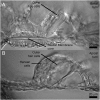Minimal basilar membrane motion in low-frequency hearing
- PMID: 27407145
- PMCID: PMC4968750
- DOI: 10.1073/pnas.1606317113
Minimal basilar membrane motion in low-frequency hearing
Abstract
Low-frequency hearing is critically important for speech and music perception, but no mechanical measurements have previously been available from inner ears with intact low-frequency parts. These regions of the cochlea may function in ways different from the extensively studied high-frequency regions, where the sensory outer hair cells produce force that greatly increases the sound-evoked vibrations of the basilar membrane. We used laser interferometry in vitro and optical coherence tomography in vivo to study the low-frequency part of the guinea pig cochlea, and found that sound stimulation caused motion of a minimal portion of the basilar membrane. Outside the region of peak movement, an exponential decline in motion amplitude occurred across the basilar membrane. The moving region had different dependence on stimulus frequency than the vibrations measured near the mechanosensitive stereocilia. This behavior differs substantially from the behavior found in the extensively studied high-frequency regions of the cochlea.
Keywords: basilar membrane; hair cells; hearing; optical coherence tomography.
Conflict of interest statement
The authors declare no conflict of interest.
Figures




Similar articles
-
Static length changes of cochlear outer hair cells can tune low-frequency hearing.PLoS Comput Biol. 2018 Jan 19;14(1):e1005936. doi: 10.1371/journal.pcbi.1005936. eCollection 2018 Jan. PLoS Comput Biol. 2018. PMID: 29351276 Free PMC article.
-
Vibration hotspots reveal longitudinal funneling of sound-evoked motion in the mammalian cochlea.Nat Commun. 2018 Aug 3;9(1):3054. doi: 10.1038/s41467-018-05483-z. Nat Commun. 2018. PMID: 30076297 Free PMC article.
-
Filtering of acoustic signals within the hearing organ.J Neurosci. 2014 Jul 2;34(27):9051-8. doi: 10.1523/JNEUROSCI.0722-14.2014. J Neurosci. 2014. PMID: 24990925 Free PMC article.
-
Tuned hair cells for hearing, but tuned basilar membrane for overload protection: evidence from dolphins, bats, and desert rodents.Hear Res. 1994 Jul;78(1):98-114. doi: 10.1016/0378-5955(94)90048-5. Hear Res. 1994. PMID: 7961182 Review.
-
Frequency tuning of mechanical responses in the mammalian cochlea.Biol Res. 1996;29(3):325-31. Biol Res. 1996. PMID: 9278704 Review.
Cited by
-
Mechanical tuning and amplification within the apex of the guinea pig cochlea.J Physiol. 2017 Jul 1;595(13):4549-4561. doi: 10.1113/JP273881. Epub 2017 May 21. J Physiol. 2017. PMID: 28382742 Free PMC article.
-
Organ of Corti vibration within the intact gerbil cochlea measured by volumetric optical coherence tomography and vibrometry.J Neurophysiol. 2018 Dec 1;120(6):2847-2857. doi: 10.1152/jn.00702.2017. Epub 2018 Oct 3. J Neurophysiol. 2018. PMID: 30281386 Free PMC article.
-
Control of hearing sensitivity by tectorial membrane calcium.Proc Natl Acad Sci U S A. 2019 Mar 19;116(12):5756-5764. doi: 10.1073/pnas.1805223116. Epub 2019 Mar 5. Proc Natl Acad Sci U S A. 2019. PMID: 30837312 Free PMC article.
-
Broad nonlinearity in reticular lamina vibrations requires compliant organ of Corti structures.Biophys J. 2023 Mar 7;122(5):880-891. doi: 10.1016/j.bpj.2023.01.029. Epub 2023 Jan 28. Biophys J. 2023. PMID: 36709411 Free PMC article.
-
Interplay between traveling wave propagation and amplification at the apex of the mouse cochlea.Biophys J. 2022 Aug 2;121(15):2940-2951. doi: 10.1016/j.bpj.2022.06.029. Epub 2022 Jun 30. Biophys J. 2022. PMID: 35778839 Free PMC article.
References
-
- von Békésy G. Experiments in Hearing. McGraw–Hill; New York: 1960.
-
- Zheng J, et al. Prestin is the motor protein of cochlear outer hair cells. Nature. 2000;405(6783):149–155. - PubMed
Publication types
MeSH terms
Grants and funding
LinkOut - more resources
Full Text Sources
Other Literature Sources

